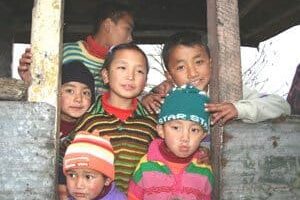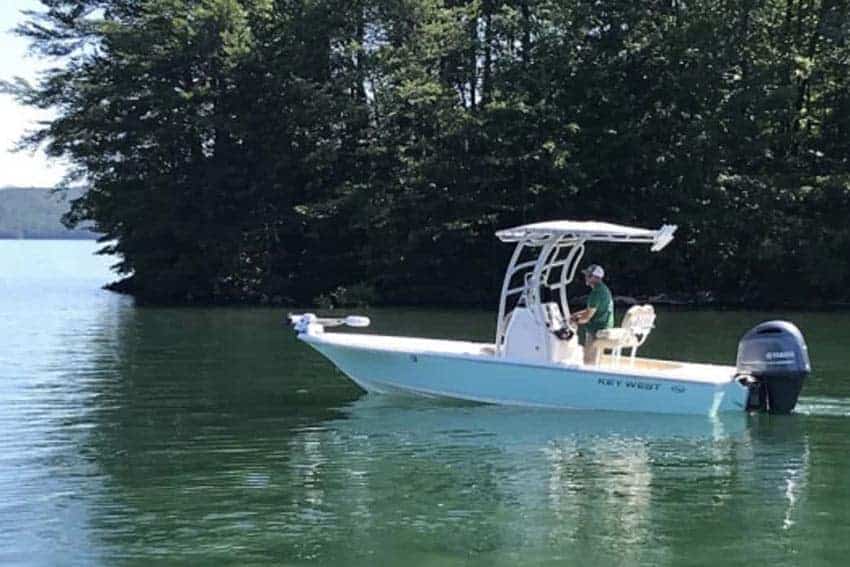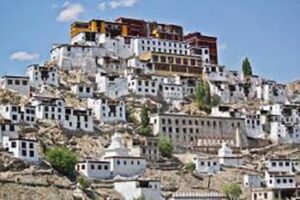
Roopkund Lake, once filled with Skeletons, and Other Mysteries
By S. Saiganesh

“A tiny jade oval concealed in a fold almost at the top of a sheer ridge, that drops down on its far side to the glacier whence the river Nandakini issues.”
Bill Aitken, the famed Indian travel writer, describes thus in a poetic vein, the high altitude lake of Roopkund.
He credits fellow mountaineer Shambu Nath Das, the ‘Sherlock Holmes from Bengal,’ with the revelation of the mystery behind the hundreds of human skeletons adorning the bottom of this hidden glacial lake at an altitude of 16,500 feet in the high Himalayas in the Uttarakhand State of Northern India.
Skeletons in the Lake
The lake is located in Nanda Devi National Park and the skeletons were discovered by a park ranger in 1942.
While most people clung to the theory that these belonged to military personnel or Tibetan traders, Das did an exhaustive study to prove them wrong through empirical evidence.
With carbon dating placing the remains at 1400 AD, the military was no longer a plausible explanation and Tibetan trade route across the impregnable Nanda Devi wall seemed a far-fetched idea.

Why Did the People Come Here?
The only reason, he concluded, that so many people could have assembled at this point was for the Bara Nanda Jat, the ritual procession that took place every twelfth year till the Homkund.
He further goes on to regard ‘Junar gali’ as an aberration of ‘Jyuri gali’ or the ‘Death alley’, named so after the accident.
Other scientists place the time of death in the ninth century and conclude that the group was killed in a hailstorm with hailstones the size of baseballs.
The Land of Myths
An interesting number of myths and folklore surround this mysterious lake, all associated with Goddess Nanda Devi. The Nanda Devi summit is worshipped as a female goddess and is the principal deity both in the Garhwal and Kumaon regions of the Himalayas.
The lake itself is believed to have been created, following Goddess Nanda’s wish to see her reflection. The Bedni kund, seen on this trail, is considered sacred and is said to be the spot where the Goddess once hid herself.
Another interesting folklore narrates the tale of a King from Rajasthan, who undertook the legendary twelfth-year pilgrimage to Homkund. His troupe, which failed to adhere to the stipulated discipline became a subject of the Goddess’s wrath, ultimately perishing in the Roopkund crater.

The local villagers, every year climb from Wan, after offering prayers to Nanda’s herald Latu, to Bedni to worship the goddess at the small abode there.
Every twelfth year witnesses an elaborate ritualistic procession from the Village Nauti, in the Nandakini valley, to Homkund. The Raja of Chandrapur donates a special four-horned ram that leads the group.
At Homkund, as the priests from Nauti culminate the ‘yatra’ [pilgrimage] with ritual offerings to the goddess, the ram, with its saddled back filled with offerings to Nanda, is let go into the inner sanctuary of the goddess.
Warm Welcome from Village Kids
The Roopkund lake is reached via a week-long trek offering the best of every kind of mountain terrain – from deciduous forests to alpine meadows to snow-covered peaks.
Our trek, organized by IndiaHikes, started from Loharjung, a tiny hamlet perched on a mountain pass, that offered a brilliant glimpse of Nanda Ghunti (the veil of the goddess) gleaming in the early morning sun.
We had reached this place the previous day, after a tiring nine-hour drive from the last railway station Kathgodam (road via Almora – Kausani – Baijnath – Gwaldam – Tharali – Debal – Mundoli).

There are two approaches to the meadows of Bedni bugyal, one from Loharjung via Didna, Tolpani and Ali bugyal and the other directly from Wan village which is connected by road.
We ascended through the first and descended the other way. At Patwal’s lodge in Loharjung, flowers of bright colors greeted us along with cheerful forktails that flew close to our heads.
On the first day we walked towards Didna, past numerous streams and bridges all along the way with clusters of geranium flowers everywhere for company.
After crossing the iron bridge over Bedni Ganga, an hour of ascent brought us to Didna campsite. Cheerful village kids greeted us with an infectious zeal and took us around the tiny hamlet with thatched houses and vast expanses of ‘Ramdana’ (a local crop) fields.

Beyond Didna were dense oak forests carpeted with a permanent cover of dry leaves. The next morning, a tiring ascent of a couple of hours brought us to Tol Khana, the first meadow beyond the tree line.
The Magical Meadows of Bedni and Ali
Half an hour from Tolkhana we were entranced by the captivating beauty of a vast expanse of verdant meadows (considered Asia’s second-largest), extending to the extent of our visions.
This was Ali bugyal. Statistics apart, the Ali Bugyal with its sheer expanse of rolling meadows set against the turquoise sky and the ‘Trishul’ summit standing guard at a far off distance, was a totally overwhelming sight.
We moved with reluctance to cover the next few kilometers till the campsite at Bedni bugyal. Bedni, in comparison to Ali, looked despoiled. A handful of cemented huts and a large steel structure erected at the center added hugely to the eyesore.

The sacred ‘kund’ (lake) with concrete embankments and seats, reminded one of an English summer resort rather than a pristine sanctuary in the hills. The place did compensate to some extent through the breathtaking views of snow-capped peaks in all directions.
The sunny morning that followed had Nandaghunti and Trishul showing up straight on our faces, flanked on their left by mighty peaks like Neelkanth, Chaukamba, Bandar Poonch, etc.
We took the trail towards our next campsite, Ghora Lotani, that revealed the mighty face of the Mrigtoli peak, whose magnificent sight continued to haunt me further till the night. The meadows here had changed from green to shades of olives and browns extended in all directions over the rugged black terrain.
Beyond Ghora Lotani the winding trail goes on a rather steep ascent till the small temple of Kalu Vinayak on the hilltop, which acts as a vantage point offering brilliant views of peaks on all sides.

The chill wind and the resounding sound of the conch shell (that our guide blew at the temple) made our bodies shiver for a moment under the thick layers of wool.
The massive white slopes of Trishul filled the entire skyline in front of us. The serene atmosphere instantly transposed one into an entranced state of sheer ecstasy.
The route from there to Bhagwabhasa campsite was mostly plane, with the slopes colored in various shades of red and maroon, from the withering grass and shrubs. The peaks constantly reminded us of their presence through occasional glimpses when the clouds cleared and the constant cold winds.
As soon as we reached our tents, violent hail storms lashed the place, turning the surface magically white.
“And hence was born the daughter of Nanda”
From Bhagwabhasa, one can clearly spot a number of glacial streams flowing down the foot of Trishul, collecting to form river Nandakini, the yellow-hued sprightly daughter of Nanda, meandering through the high valleys of Garhwal to merge as one with the Ganges at the sacred site of Nandaprayag.

The widest of such streams flowing from a height of about 50 feet made an exquisite waterfall washing the feet of Trishul. Undeterred by rain and hail storms I was drawn to this spot of virginal beauty and descended the steep grassy slopes devoid of trails.
The place was a due reward. The sky and the landscape displayed a riot of numerous hues as the icy stream galloping over rounded boulders caressed my naked feet. As the light got dimmer, I had to rush towards our tents in a hurry.
To Paradise and Back
Starting early the next day in the spine-chilling cold, we reached the snow line in an hour’s time. The ice was hard and demanded caution. After the last tricky ascent on ice, we reached the Roopkund crater in two hours, to face blindingly bright snowfields in all directions.
The lake at the bottom of the crater with steep walls sliding into it had inches of snow covering the surface, depriving us of any views of the water surface or the skeletons.
From here a 750-foot steep ascent leads to Junar Gali ridge, which offers an unobstructed view of the Trishul summit and everything beyond. We offered our prayers to Goddess Nanda in the small shrine on top for making our trek a grand success.
The same day we descended to Bedni, despite incessant hail and rains. Whatever little inconvenience the altitude had caused to our bodies cured immediately on descending to a lower height.
The day after that was a straightforward descent to Wan village, from where we took a jeep to Loharjung. And here we roamed around happily examining every little thing that was for sale in the ‘bazaar’. After a good night’s sleep a long road journey awaited us to reach the railway station and from there to our respective cities in the plains.
 S. Saiganesh is an engineer from Pune, India, who loves to travel, trek, and hike. “I constantly strive to showcase lesser-known places and unexplored travel destinations through my web page,” he writes “and also try to provide sufficient directions and pointers for readers to prepare their own itinerary.” Visit his website, Mostly Footloose.
S. Saiganesh is an engineer from Pune, India, who loves to travel, trek, and hike. “I constantly strive to showcase lesser-known places and unexplored travel destinations through my web page,” he writes “and also try to provide sufficient directions and pointers for readers to prepare their own itinerary.” Visit his website, Mostly Footloose.
- Arezzo, Tuscany: A Stunning Find - September 3, 2024
- Fall Clothing for Your Travels - August 30, 2024
- Mekong Chronicles: The River That Shaped Southeast Asia - August 28, 2024





